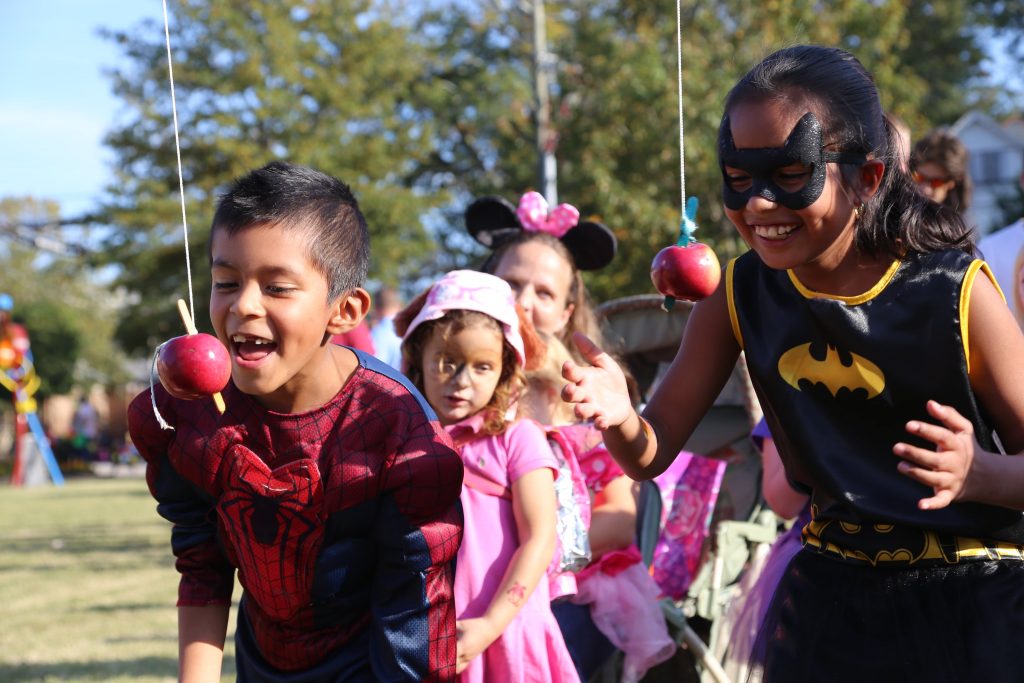Chapter 4: Simple Present & Present Progressive
Holidays & Special Occasions
 Learning Goals
Learning Goals
At the end of this chapter you should be able to:
- Identify the difference in form between the simple present and present progressive by recognizing -s, -ing, and the auxiliary BE verb.
- Recognize the difference in use and meaning between the simple present and present progressive.
- Recognize and use signal words to determine which tense is being used.
- Recognize and use stative verbs in the simple present tense.

 Prepare
Prepare
Activity 4.1: Prereading
Part 1 Directions: Sit with a partner or a group. Describe a typical celebration for yourself or a family member. Use the simple present tense. What activities do you usually do for birthday celebrations?
- Do you have a party?
- What activities do you usually do?
- Who is invited to the celebration?
- Where is the celebration?
- Do you go out to lunch or dinner?
- Do you get presents?
Part 2 Directions: Look at the picture of the woman celebrating her birthday. Now IMAGINE that TODAY is your birthday or a family member’s birthday. Use the present progressive tense because the activities are happening now.
- What are you doing for your celebration? Describe the
celebration. - Are you having a party?
- What kind of cake are you eating?
- What presents are you opening?
- Where are you having your celebration?
- Who is coming to your party?
- What food are you having?
 Read
Read
Directions: Read this story out loud with a partner. One person reads a paragraph, then the other person reads the next paragraph. When you are finished, read the story again. This time, read the paragraphs you did not read.
Celebrating Together During Winter Break
Right now, it is winter break. It is too expensive for Yuri and Palani to fly home to their countries. Palani doesn’t usually celebrate the Christmas holiday. Ana and Pedro miss their family in Guatemala. Their grandmother usually cooks delicious food for the whole family. Tatiana and Viktor usually celebrate Orthodox Christmas. They exchange presents and gifts on January 7th instead of December 25th.
This year, the six friends want to do something different for the holidays. They are celebrating together at Ana and Pedro’s house. Today is Christmas day. Everyone is making some traditional American dishes to try. Ana and Pedro are preparing a turkey with stuffing. Palani and Yuri are bringing mashed potatoes with gravy and carrots. Tatiana and Viktor are bringing dinner rolls and pumpkin pie for dessert.
Everyone is so happy to be together this holiday season. They are excited to try out new foods and learn about new traditions. It is hard coming to a new country and starting a new life, but friends make it much easier.
Activity 4.2: Comprehension
Directions: Verb tenses tell us about time. Decide if a sentence is talking about a routine or repeated activity, or if the activity is happening right now. Write Routine or Right Now on the blank line.
1. For Christmas, Yuri, Palani, Ana, Marco, Tatiana, and Viktor are spending the holiday together.
___________________________________________________________________
2. Palani doesn’t usually celebrate Christmas.
___________________________________________________________________
3. Ana and Pedro are thinking about their family back home in Guatemala.
___________________________________________________________________
4. Their grandmother usually cooks delicious food for the whole family.
___________________________________________________________________
5. Tatiana and Viktor usually celebrate Orthodox Christmas.
___________________________________________________________________
6. They usually exchange presents and gifts on January 7th instead of December 25th.
___________________________________________________________________
7. They are celebrating together at Ana and Pedro’s house.
___________________________________________________________________
8. Tatiana and Viktor are preparing a turkey with stuffing.
___________________________________________________________________
9. Palani and Yuri are bringing mashed potatoes with gravy and carrots.
___________________________________________________________________
10. Tatiana and Viktor are bringing dinner rolls and pumpkin pie for dessert.
___________________________________________________________________
Activity 4.3: Complete the Table
Directions: Read the sentence in column one. Determine whether or not the action of the sentence is happening now or routinely. Choose the correct word: now or routine.
Then determine if the verb tense in the sentence is present progressive (PP) or simple present (SP). Use signal words to help you. Write PP or SP in the third column to indicate the tense.
Remember
| Sentence | Now or Routine | SP or PP |
|---|---|---|
| Example: We like to eat out on the weekends. |
now | SP |
| 1. We usually eat at restaurants. | now
routine |
|
| 2. We are eating at a restaurant. | now
routine |
|
| 3. I am ordering a sandwich. | now
routine |
|
| 4. I often order a chicken sandwich. | now
routine |
|
| 5. He always drinks lemonade. | now
routine |
|
| 6. Today, he is drinking coffee instead. | now
routine |
|
| 7. She often pays with a credit card. | now
routine |
|
| 8. She is paying with cash today. | now
routine |
 Explore
Explore
Activity 4.4: Try It Out!
Directions: On the line below, write the simple present or present progressive form of the verb in parentheses.
1. Yuri (cook) _________________________ Maa Po for dinner tonight.
2. The friends (celebrate) ______________________ at Ana and Pedro’s apartment this year.
3. I (like) _________________________ to cook Chinese food at home because it’s healthy.
4. Ana and Pedro (decorate) ____________________ their apartment for Christmas this year.
5. Tatiana usually (open) _________________________ presents on January 7th.
6. This year, Tatiana (open) _________________________ presents on December 25th.
7. Yuri (cook) _________________________ Chinese dishes, like Maa Po all the time.
8. Pedro (prepare) _________________________ tamales for Christmas dinner every year.
9. Right now, Ana and Pedro (drink) ________________________ horchata, a Mexican drink.
10. Everyone (want) _________________________ to sing Christmas songs.
 Discover
Discover
Uses of the Simple Present Compared to the Present Progressive
Look at the table below to see when to use the simple present or the present progressive.
| Simple Present | Present Progressive |
|---|---|
| Facts, general truths, & information: Birthdays occur every year. Everyone gets older. |
Happening now, right now, or at this moment: You are reading this sentence. You are getting older right now. |
| Usual activities, habits, routines, & repeated actions (sometimes, every day): Juan has a big birthday party every year. Ahmed always eats cake at his birthday party. Suzie doesn’t eat cake for her birthday anymore. Jim blows up balloons for all the parties. |
Extended time: recent past through near future: You are studying grammar this term. We are buying gifts for Grandpa this week. |
| A temporary arrangement: Jose is working the night shift this week only. Olena is living in Portland for one year while she goes to college. |
Activity 4.5: Choose the Best Option
Directions: Work with a partner. Try to identify why the simple present or present progressive is used. Use the words from the table above to identify the use.
Examples
It is Christmas break.
fact, general truth, information
John is dancing at the party.
happening now
Suzanne is studying ESL this term.
extended time
Ahmed’s party is always held at a hotel.
repeated action
1. The classmates are spending the holiday together.
___________________________________________________________________
2. It is too expensive for Yuri and Palani to fly home.
___________________________________________________________________
3. Their grandmother usually cooks delicious food.
___________________________________________________________________
4. This year, they are celebrating together at Ana and Pedro’s house.
___________________________________________________________________
5. They are preparing an American-style dinner.
___________________________________________________________________
6. They are inviting all their classmates.
___________________________________________________________________
7. Yuri, Palani, Tatiana, and Viktor are spending the night.
___________________________________________________________________
8. They want to sing Christmas carols on Christmas eve.
___________________________________________________________________
9. At this time, Tatiana and Viktor are making breakfast.
___________________________________________________________________
10. It takes a long time to prepare a Ukrainian breakfast.
___________________________________________________________________
Signal Words
The signal words below help us to understand whether something is happening now or it is routine. We can look for these words when we’re reading, and we can use these words when we are writing. We can also hear them when we are listening and use them when we are speaking.
| Simple Present | Present Progressive |
|---|---|
| Adverbs of frequency (AoF) are used with the simple present to show how often something happens.
always, often, |
These words signal that the event is happening now and should be in the present progressive.
at the moment, now, |
| These words tell us how often an event or action is repeated or routine.
every day, every week, every year, |
These words show extended time that starts in the recent past and continues into the near future.
today, soon / very soon, |
Activity 4.6: Writing
Directions: Now that you know some good signal words for simple present and present progressive, write some sentences using signal words.
Imagine that it’s New Year’s Eve. Describe a typical New Year’s Eve celebration for you in your country. Then describe the celebration as if it were happening right now in the United States.
Write 3 sentences in the simple present using the appropriate signal words.
Examples
Alex’s parties are never boring!
Write 3 sentences in the present progressive using the appropriate signal words.
Examples
My dad is shopping for balloons, streamers, food, and gifts this week.
Simple present sentences:
1. _____________________________________________________________________
2. _____________________________________________________________________
3. _____________________________________________________________________
Present progressive sentences:
1. _____________________________________________________________________
2. _____________________________________________________________________
3. _____________________________________________________________________
Now, share your sentences with a partner or group.
Activity 4.7: Listening
Directions: Listen for the simple present or present progressive. Write the correct form of the verb on the line.
This year, my husband and I (1)__________ to England in November for two weeks. It (2)__________ strange to celebrate Thanksgiving in England where they do not (3)__________ this holiday. We usually (4)__________ our family to eat dinner at our house. At home, our family (5)__________ early on Thanksgiving morning. We play football outside before dinner. We (6)__________ a big turkey. We (7)__________ stuffing. We (8)__________spaghetti squash, bread rolls, fruit salad, and green beans. For dessert, I usually (9)__________ apple pie, but my sister (10)__________ pumpkin pie topped with whipped cream. In England, everyone (11)__________. Nobody (12)__________ the day off. Right now, we (13)__________fish and chips in a pub*. After dinner we (14)__________ to visit the Christmas market along the river Thames. We (15)__________ souvenirs for our family and friends. We (16)__________to look at all the important places lit up at night.
*A pub is like a small cafe or bar. It serves beer, wine, and hard alcohol, but it also sells soft drinks and tea. Families come to the pub together to talk and laugh and listen to music or eat a meal.
Stative (Non-Action) Verbs
As you know from studying verbs in Chapter 1, most verbs show an action; for example, walk, talk, study, and go. However, some verbs don’t show action. The BE verb, for example, does not show action.
Instead, stative verbs show an INTERNAL or MENTAL state. These internal states happen in our minds and are not seen by others. Because these verbs do not show external or physical action, they are rarely used in the present progressive.
As you can see from the list below, these verbs usually show INTERNAL or MENTAL actions.
-
- Attitudes: want, like, hate
- Beliefs: believe, know, think, understand
- Senses: see, hear, feel
- Possession: have, own, belong
- Emotions: doubt, wish, care
- Thinking / cognitive: understand, remember, forget
Think:
The verb think can be an active or stative verb. It depends on how it is being used.
If you are expressing opinions, then it is a stative verb because it is a mental or internal activity.
If it is used to describe the act of keeping someone or something in your mind, then it is an active verb.
Example
Stative: I think that Thai food is too spicy.
Active: I’m thinking about my sister today.
Activity 4.8: Multiple Choice
Directions: Decide if the following sentences use an action or stative (non-action) verbs. Choose active or stative.
Example
1. I am from Ukraine.
active stative
2. Palani doesn’t usually celebrate Christmas
active stative
3. Tatiana wants to make blini “pancakes.”
active stative
4. Grandma cooks delicious food.
active stative
5. Can you hear the music?
active stative
6. Do you know my brother, Palani?
active stative
7. They exchange presents every year.
active stative
8. She likes Caravan tea from Russia.
active stative
9. Ana and Pedro love their aunt and uncle.
active stative
10. Ana and Pedro make tamales from scratch.
active stative
11. Viktor prefers to celebrate Christmas on Jan 7th.
active stative
12. Do you understand non-action verbs?
active stative
Activity 4.9: Choose the Best Option
Directions:
- Decide if each sentence is in the simple present tense or the present progressive. Write SP (for Simple Present) or PP (for Present Progressive) on the first line.
- Then decide if the verb used is an active verb or a stative verb. Write active or stative on the second line.
Example
1. _____They want to have a Christmas party.
________
2. _____ He has new shoes for his birthday.
________
3. _____ Today, they are having a birthday party for their daughter.
________
4. _____ Some people prefer to celebrate New Year’s Eve all night!
________
5. _____ Javier is listening to Christmas music at this moment.
________
6. _____ The food tastes delicious.
________
Activity 4.10: Conversation
Have some short conversations using the simple present and the present progressive. If you notice your partner using the wrong verb form, talk about it.
Part 1 Directions: Use the present progressive to tell your partner about the following:
- a subject you are studying this term (e.g., grammar, reading, pronunciation)
- an activity that you are doing this term (e.g., dancing, swimming, walking, playing cards)
Part 2 Directions: Use the simple present to tell your partner about the following:
- something that regularly happens in your daily life (take child to school, go to the gym)
- something you do every morning, every night, or every weekend.
Part 3 Directions: Use the simple present with stative verbs to tell your partner about:
- something you have (e.g., carry and use) in your backpack, purse, or wallet (e.g., money, books, cell phone)
- something that you currently want or need (e.g., eggs, toothpaste, pencils)
Activity 4.11: Noticing
Directions: Read the story. Choose (by underlining or otherwise marking) the simple present verbs. Choose (by circling or otherwise marking) the present progressive verbs.
Writing in My Journal
I am a student. I study English. I write in a journal every day for my writing class. I often write about my feelings. Sometimes I draw pictures. I don’t worry about spelling or punctuation in my journal. Right now, I’m sitting in a restaurant. I’m looking at people and writing about them. The woman across from me is not drinking her coffee. She’s typing on her laptop. Maybe she’s writing a journal, too.
Activity 4.12: Writing
Directions: Write an answer to each question. Write short answers using contractions if the answer is negative.
Remember
Examples
Are you a student? No, I’m not.
Do you have cats? Yes, I do.
1. Are you married?
__________________________
2. Do you drive to work?
__________________________
3. Do you have children?
__________________________
4. Are you hungry?
__________________________
5. Does the teacher have a pet?
__________________________
6. Are you writing in your book right now?
__________________________
7. Are you washing dishes right now?
__________________________
8. Do you want to buy a new car?
__________________________
9. Are you a student?
_________________________
10. Do you live in an apartment?
_________________________
11. Are you cleaning your house now?
_________________________
12. Do you know the alphabet?
_________________________
13. Are you busy?
_________________________
14. Are you an office assistant?
_________________________
Activity 4.13: Conversation
Directions: Ask and answer questions about the picture of kids celebrating Halloween. Use both the simple present and the present progressive.
Remember
If you hear a question with the BE verb, use the BE verb to answer.
If you hear a question with the DO/DOES auxiliary, use DO/DOES to answer.
Short Answers: Simple Present vs. Present Progressive
| Subject | Short Answer Simple Present |
Short Answer Present Progressive |
|---|---|---|
| I | Yes, I do. No, I don’t. |
Yes, I am. No, I’m not. |
| you | Yes, you do. No, you don’t. |
Yes, you are No, you aren’t. |
| he she it |
Yes, he does. No, he doesn’t. |
Yes, he is. No, he isn’t. |
| we | Yes, we do. No, we don’t. |
Yes, we are. No, we aren’t. |
| they | Yes, they do. No, they don’t. |
Yes, they are. No, they aren’t. |
Examples
Are the kids having fun? Yes, they are.
Do you like to celebrate Halloween? Yes, I do.
Activity 4.14: Writing
Part 1 Directions: Think about your friends or family. What do they do every day? What are they doing right now? Pick ONE person, and write some sentences about their daily activities. Use BOTH the simple present and the present progressive. If you use a stative verb, use it ONLY in the simple present.
Examples
My husband is at home.
He likes to cook.
He is cooking dinner.
He knows how to cook many things.
1. _______________________________________________________________
2. _______________________________________________________________
3. _______________________________________________________________
4. _______________________________________________________________
Part 2 Directions: Tell your partner about your friend or family member. Use both the simple present and the present progressive. Your partner should ask some questions. You can answer using short answers. Have fun!
Present Progressive: Temporary State
Review the uses of the simple present and present progressive. Sometimes the present progressive tense tells us that an activity is temporary, and the simple present tells us that an activity is more permanent. So the verb tense we choose says something more about the sentence than we realize.
Examples
I live in Happy Valley. (I live there all the time.)
I am living in Happy Valley. (I live there now, but I plan to move to another place soon.)
I work as a cashier. (This is my career.)
I am working as a cashier. (Right now, I am a cashier, but I want to have a different job).
Activity 4.15: Choose the Best Option
Directions: Decide if you should use the simple present or the present progressive in the following sentences.
1. (I am going to school for only 1 term.)
a. I attend Clackamas Community College.
b. I am attending Clackamas Community College.
2. (I live there all the time.)
a. I live with my sister.
b. I am living with my sister.
3. (I am vegetarian on Fridays during Lent.)
a. I don’t eat meat on Fridays.
b. I am not eating meat on Fridays.
4. (temporary job)
a. I work at a department store.
b. I am working at a department store during the holidays.
5. (A temporary way to get to work because my car is broken down.)
a. I take the bus to work.
b. I am taking the bus to work this week.
6. (I don’t eat before sundown during Ramadan.)
a. I don’t eat during the day.
b. I’m not eating during the day.
 Review
Review
Activity 4.16: Fill-in-the-Blank
Part 1 Directions: Gloria and Esperanza are in the library (right now). Complete the dialogue with the correct form of the verb in parentheses.
Remember
Look for signal words to help you decide the right tense.
Put stative verbs in the simple present (not present progressive).
Esperanza: Hi, Gloria. What are you doing here?
Gloria: I __________________ (look) for a book about U.S. presidents. How about you?
Esperanza: I _________________ (return) a book.
___________________ (you/want) to go for a cup of coffee?
Gloria: Sorry, I can’t right now. I __________________ (wait) for my friend.
Today, we ___________________ (work) on a project for history class together.
We _______________ (need) to finish it by next week.
Esperanza: _________________ (you/like) your history class?
Gloria: Yes. I really ________________ (like) the teacher.
He always _________________ (wear) jeans to class, and he ________________ (have) an earring in one ear.
Part 2 Directions: Take turns reading the dialogue. One person takes the role of Gloria. The other person takes the role of Esperanza. Help each other pronounce the words. You can even give a performance of your reading to the class.
Activity 4.17: Error Correction
Directions: Read each sentence and think about the verb form. If there is a mistake, correct it.
1. I want to learn English.
2. Every morning, I like to drink coffee.
3. Two days a week, I am going to the gym.
4. I am loving to exercise at the gym.
5. I want to practice English with native speakers.
6. Now, I study English and look for a job.
7. I work Monday through Friday.
8. I am happy because I understand English.
9. I am study English this term.
10. I often practice English.
Activity 4.18: Fill-in-the-Blank
Directions: Write the correct verb forms on the lines. Use either the simple present or the present progressive.
Remember
Use signal words to help you determine the correct tense.
Use stative verbs in the simple present (not in the present progressive).
Don’t forget that “think” can be active or stative depending on how it is used.
Right now I (1. write) _______________ in my journal. It (2. snow)
_______________ outside. I (3. think) ____________________ about my
family. I (4. think) _____________________ about my family every day.
I (5. speak) _____________ with my family every weekend. My mother
_____________ (6. send) me letters every week, but I still miss them.
Oh! The phone (7. ring) _____________________. Maybe my father
(8. call) ________________. He always (9. call) ___________________ on
Sunday.
 Self-Assessment
Self-Assessment
These were our goals at the beginning of Chapter 4:
- Identify the difference in form between the simple present and present progressive by recognizing the grammatical markers (e.g., -s, -ing, auxiliary BE verb).
- Recognize the difference in use and meaning between the simple present and present progressive.
- Recognize and use signal words to determine which tense is being used.
- Recognize and use stative verbs in the simple present tense.
Directions: Choose yes or no in the table below if you think you have achieved the goals. Write an example of the goal in the last column.
| I can… | I achieved this goal: | My example: |
|---|---|---|
| recognize the simple present form | yes
no |
I walk, you walk, he walks, we walk, they walk |
| recognize the present progressive form | yes
no |
|
| use spelling rules to write the third person singular -s | yes
no |
|
| recognize and use signal words |
yes
no |
|
| recognize stative verbs | yes
no |




